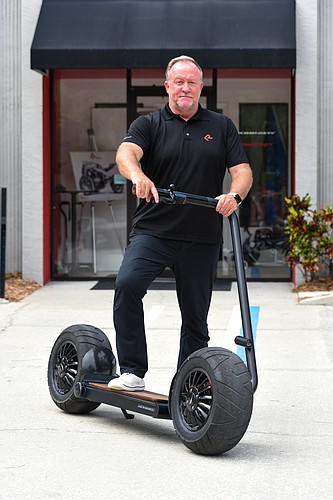- April 11, 2025
-
-
Loading

Loading

Around 15 years ago, Rob Brady took his Sarasota-based product design company, Robrady, in a new direction. He discovered the health care industry was in need of product design services. So Brady, CEO and design director, changed his focus to target medical fields. Now, it’s most of what Robrady does.
“It’s really about doing noble work,” Brady says. This change in his company has had a lasting impact on the health care industry itself, as well as the Robrady team. “We get a bonus when we do a good job,” he says. “When we do work that will help the health of people, that’s lasting. That sticks with you.” The products Robrady designs for the health care industry focus on removing pain and improving daily life. A significant part of introducing product design to the health care industry involved a lot of ergonomic research. Brady spent a lot of time immersing himself in learning about what type of products the industry needed. That research continues today in the products the company designs. The Robrady team spends time ensuring a product is durable and cost efficient. Brady also says a lot of his work involves understanding regulations so products can be taken to market. Brady leads his team in a way that they’re always trying to determine how much of a change they can make — how far to push things. And because Brady is constantly pushing the boundaries of product design to create more change in the world, he currently has a “whole host” of new ventures seeking Robrady out to design products. In order to enact change in the health care industry, Brady and his team have to ask a lot of questions along the way. They've made some mistakes, too. On that, Brady will tell you failing is just part of the job. He encourages the team to fail early, so the product is a success in the long run. That’s why Brady’s motto is to challenge and question everything. From the mock-ups to the model, he’s learned to question every detail to sand down the product to perfection. Something you’ll often hear Brady tell his team and clients is, “Challenge your solution.” When a customer comes in with a challenge, the team’s first question is always “why?” A great example of challenging the solution, Brady says, comes from a partnership with GMX 7, an athletic gear company. When David McCagg, founder and CEO of GMX 7, came to Brady with an idea of designing a new aquatic resistance training product, Brady questioned the original design brought forth. “We design things in that way to create solutions,” he says. For years, swimmers have relied on power towers, parachutes, water belts and stretch cords for resistance training. Every single product had a downside whether it was just too big or broke too easily. By the time Brady was done with it, the product was life-changing for swimmers. The X-1 Pro is compact and portable. The resistance levels provide endless workouts for swimmers of all levels. It wasn’t a finalized product just like that. The product went through a number of changes and different models before it was gold medal-worthy. The X-1 Pro was a finalist on the America by Design TV series, where Olympic swimmer Ryan Lochte, in the first episode, discusses the product’s impact on his life. “I’ve tried every resistance tool and, hands down, this is the best one,” Lochte says in the show. “If you don’t have this as a swimmer, you’re going to fall behind.” Another life changing product Robrady designed is the SafER portable negative pressure system product — something especially important during the pandemic. The SafER system, a face shield that uses a vacuum to direct the flow of air, provides defense against exposure and spread of airborne contaminants. A study showed the shield removes over 93% of 0.5 micron-sized particles that are exhaled. “We think this is another layer of keeping health care workers safe,” Brady says. The company has also created a product called PILL designed to stop an opioid addiction before it even starts. An acronym that stands for Prescribed Interval Limit Lock, PILL hasn’t made it to market yet, but here’s how it works: a doctor creates an order for a specific medicine, dosage and regime. The manufacturer would follow the order and set the timer inside the PILL device prior to the patient receiving it. Then the device would serve pills at the prescribed interval. The device could be a key weapon in the fight against the national opioid crisis. Again, Brady is thinking big changes to make a big impact. “No one wakes up planning to become an addict,” Brady says.